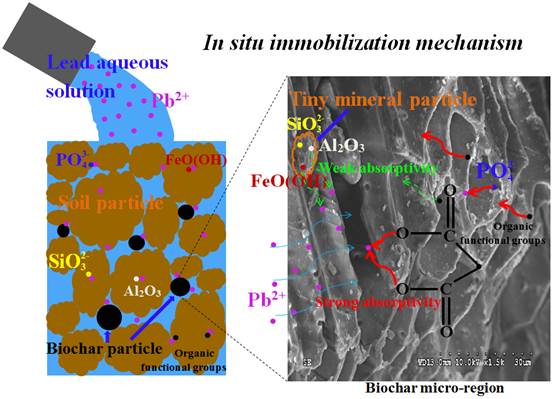| Sorption of Lead in Soil Amended with Coconut Fiber Biochar: Geochemical and Spectroscopic Investigations |
| From: PublishDate:2020-07-31 Hits: |
Biochar, an eco-friendly amendment, has been extensively studied as a technology for immobilizing heavy metal contaminants in soils. It was reported that mineral oxides (iron oxide), clay minerals and organic matters in the soil played an important role in retaining heavy metals. Many studies have found that biochar amendments can significantly enhance the sorption capacities of heavy metals in acidic soils. Few studies, however, have clearly investigated the sorption capacity of CFB particles, mineral oxides, clay minerals, and organic matters to heavy metals and its mechanisms in soils. A collaborative team between Hainan University and Foshan University has gained insight into the dynamical behaviors of coconut fiber-derived biochar (CFB) to enhance the immobilization capacity of the studied soil for lead (Pb) and its mechanisms. Their research was published in Geoderma on 15 September 2019.
The figure presents graphical synopsis on the dynamical behaviors of CFB to enhance the immobilization capacity of the studied soil for Pb and its mechanisms. The CFB particles possibly offer more binding sites of PO43- and carboxylic functional groups (with strong absorptivity) than the binding sites of -FeO(OH), SiO32-, Al2O3 and organic functional groups provided by the original soil particles alone (no biochar) for Pb. The team found that after CFB treatments (at 2% and 4% (w/w)) and aging, the immobilized Pb (non EDTA extractable Pb) in the CFB-amended soil (with Pb of 600 mg kg-1) increased significantly with the increase of the CFB addition under geochemical investigations, that is, CFB amendment can significantly enhance the capacity of soil to immobilize Pb. The immobilized Pb in CFB-amended soil enhanced by CFB is optimized at 90-day of incubation and tends to be constant. The Pb content in organic matter bound fraction of the CFB-amended soil (with 2% and 4% CFB) increased by 29.5% and 33.5%, respectively, compared to the control soil after 150-day of incubation. The mapping results showed that, more Pb was absorbed by CFB particles in the micro-region of CFB-amended soil rather than soil particles using the synchrotron radiation based μ-XRF at BSRF; While the XAFS results found that, the relative contents of Pb-loaded humic acid (HA) and Pb3(PO4)2 were increased by 12.5% and 6.1% in the CFB-amended (2% CFB) soil compared to the un-amended soil, respectively, after 150-day of incubation. The species of Pb(C2H3O2)2 (with a similar structure of C-O-Pb-O-C) account for 71.3% in Pb-loaded HA. Overall, the original soil particles could offer binding sites of -FeO(OH), SiO32-, Al2O3 and organic functional groups for Pb as the CFB-amended soil was contaminated by Pb. The CFB particles, however, provide more binding sites of carboxylic functional groups and PO43- (with strong absorptivity) for Pb, thus, the CFB-amended soil has a higher immobilization capacity for Pb as compared with the control soil. The research provides the scientific community clues to understand the dynamical behaviors and mechanisms of biochar to immobilize Pb in contaminated soils. Synchrotron sources have helped the team to unveil the spatial distribution of heavy metals on biochar particles and soil particles, as well as the molecular species of heavy metals absorbed by soil components. “Most of the physical and chemical reactions of biochar to heavy metal contaminants such as the sorption, precipitation, complexation and chelation were mainly occurring on the surface of the biochar skeleton. Thus, the surface sorption and immobilization mechanisms of pristine and chemically modified biochar to heavy metals and/or other pollutants need to be further studied before the application of biochar-based amendments. The finer light spot of synchrotron beams would surely help to explore the in situ molecular mechanisms of biochar-based amendments to adsorb and immobilize heavy metals and/or other pollutants.” explains Weidong Wu, the team leader and the professor of Institute of Tropical Crops, Hainan University. Article: Jianhong Li, Shan-Li Wang, Lirong Zheng, Dongliang Chen, Zhipeng Wu, Yu Xie, Weidong Wu*, Nabeel Khan Niazi, Yong Sik Ok, J?rg Rinklebe, Hailong Wang* Sorption of lead in soil amended with coconut fiber biochar: Geochemical and spectroscopic investigations. Geoderma 350(2019), 52–60. |
|
|
| Chinese
- Metal-free efficient photocatalyst for stable visible water splitting——Top ten major scientific progresses in China in 2015
- The nano-resolution imaging platform was awarded the first rate prize of Beijing Science and Technology in 2014
- Beamline 1W1 of BSRF started to runoperate in the couplingparasitic mode of BEPCII
- Synthesis of High Performance Polymer Materials for Field Effect-Transistors
- Surfactant molecular aggregates in green solvents
- GIXRD has played an important role in the characterization of organic thin-film transistors
Science Highlights
Home /
Copyright © 2011 - 2012 Beijing Synchrotron Radiation Facility


